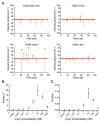Single-Molecule Two-Color Coincidence Detection of Unlabeled alpha-Synuclein Aggregates
- PMID: 36762870
- PMCID: PMC10946743
- DOI: 10.1002/anie.202216771
Single-Molecule Two-Color Coincidence Detection of Unlabeled alpha-Synuclein Aggregates
Abstract
Protein misfolding and aggregation into oligomeric and fibrillar structures is a common feature of many neurogenerative disorders. Single-molecule techniques have enabled characterization of these lowly abundant, highly heterogeneous protein aggregates, previously inaccessible using ensemble averaging techniques. However, they usually rely on the use of recombinantly-expressed labeled protein, or on the addition of amyloid stains that are not protein-specific. To circumvent these challenges, we have made use of a high affinity antibody labeled with orthogonal fluorophores combined with fast-flow microfluidics and single-molecule confocal microscopy to specifically detect α-synuclein, the protein associated with Parkinson's disease. We used this approach to determine the number and size of α-synuclein aggregates down to picomolar concentrations in biologically relevant samples.
Keywords: Aggregation or Oligomerization; Fluorescence; Microscopy; Proteins; Single-Molecule.
© 2023 The Authors. Angewandte Chemie International Edition published by Wiley-VCH GmbH.
Conflict of interest statement
The authors declare no conflict of interest.
Figures





Similar articles
-
Single-Molecule Two-Color Coincidence Detection of Unlabeled alpha-Synuclein Aggregates.Angew Chem Weinheim Bergstr Ger. 2023 Apr 3;135(15):e202216771. doi: 10.1002/ange.202216771. Epub 2023 Feb 28. Angew Chem Weinheim Bergstr Ger. 2023. PMID: 38516037 Free PMC article.
-
High Selectivity and Sensitivity of Oligomeric p-Phenylene Ethynylenes for Detecting Fibrillar and Prefibrillar Amyloid Protein Aggregates.ACS Chem Neurosci. 2019 Mar 20;10(3):1813-1825. doi: 10.1021/acschemneuro.8b00719. Epub 2019 Feb 6. ACS Chem Neurosci. 2019. PMID: 30657326
-
Synergistic Amyloid Switch Triggered by Early Heterotypic Oligomerization of Intrinsically Disordered α-Synuclein and Tau.J Mol Biol. 2018 Aug 3;430(16):2508-2520. doi: 10.1016/j.jmb.2018.04.020. Epub 2018 Apr 25. J Mol Biol. 2018. PMID: 29704492
-
Insights into the Molecular Mechanisms of Alzheimer's and Parkinson's Diseases with Molecular Simulations: Understanding the Roles of Artificial and Pathological Missense Mutations in Intrinsically Disordered Proteins Related to Pathology.Int J Mol Sci. 2018 Jan 24;19(2):336. doi: 10.3390/ijms19020336. Int J Mol Sci. 2018. PMID: 29364151 Free PMC article. Review.
-
Small molecule-based fluorescent probes for the detection of α-Synuclein aggregation states.Bioorg Med Chem Lett. 2023 Apr 15;86:129257. doi: 10.1016/j.bmcl.2023.129257. Epub 2023 Mar 24. Bioorg Med Chem Lett. 2023. PMID: 36966976 Review.
Cited by
-
Single-Molecule Two-Color Coincidence Detection of Unlabeled alpha-Synuclein Aggregates.Angew Chem Weinheim Bergstr Ger. 2023 Apr 3;135(15):e202216771. doi: 10.1002/ange.202216771. Epub 2023 Feb 28. Angew Chem Weinheim Bergstr Ger. 2023. PMID: 38516037 Free PMC article.
-
α-Synuclein oligomers form by secondary nucleation.Nat Commun. 2024 Aug 17;15(1):7083. doi: 10.1038/s41467-024-50692-4. Nat Commun. 2024. PMID: 39153989 Free PMC article.
-
In situ single-molecule investigations of the impacts of biochemical perturbations on conformational intermediates of monomeric α-synuclein.APL Bioeng. 2024 Mar 1;8(1):016114. doi: 10.1063/5.0188714. eCollection 2024 Mar. APL Bioeng. 2024. PMID: 38435467 Free PMC article.
-
Two-color coincidence single-molecule pulldown for the specific detection of disease-associated protein aggregates.Sci Adv. 2023 Nov 17;9(46):eadi7359. doi: 10.1126/sciadv.adi7359. Epub 2023 Nov 15. Sci Adv. 2023. PMID: 37967183 Free PMC article.
-
Sequential replacement of PSD95 subunits in postsynaptic supercomplexes is slowest in the cortex.Elife. 2024 Nov 21;13:RP99303. doi: 10.7554/eLife.99303. Elife. 2024. PMID: 39570289 Free PMC article.
References
-
- Spillantini M. G., Schmidt M. L., Lee V. M.-Y., Trojanowski J. Q., Jakes R., Goedert M., Nature 1997, 388, 839–840. - PubMed
-
- Polymeropoulos M. H., Lavedan C., Leroy E., Ide S. E., Dehejia A., Dutra A., Pike B., Root H., Rubenstein J., Boyer R., Stenroos E. S., Chandrasekharappa S., Athanassiadou A., Papapetropoulos T., Johnson W. G., Lazzarini A. M., Duvoisin R. C., Di Iorio G., Golbe L. I., Nussbaum R. L., Science 1997, 276, 2045–2047. - PubMed
-
- Zarranz J. J., Alegre J., Gómez-Esteban J. C., Lezcano E., Ros R., Ampuero I., Vidal L., Hoenicka J., Rodriguez O., Atarés B., Llorens V., Gomez Tortosa E., del Ser T., Muñoz D. G., de Yebenes J. G., Ann. Neurol. 2004, 55, 164–173. - PubMed
-
- Lesage S., Anheim M., Letournel F., Bousset L., Honoré A., Rozas N., Pieri L., Madiona K., Dürr A., Melki R., Verny C., Brice A., Ann. Neurol. 2013, 73, 459–471. - PubMed
-
- Singleton B., Farrer M., Johnson J., Singleton A., Hague S., Kachergus J., Hulihan M., Peuralinna T., Dutra A., Nussbaum R., Lincoln S., Crawley A., Hanson M., Maraganore D., Adler C., Cookson M. R., Muenter M., Baptista M., Miller D., Blancato J., Hardy J., Gwinn-Hardy K., Science 2003, 302, 841. - PubMed
Publication types
MeSH terms
Substances
Grants and funding
LinkOut - more resources
Full Text Sources
Medical

